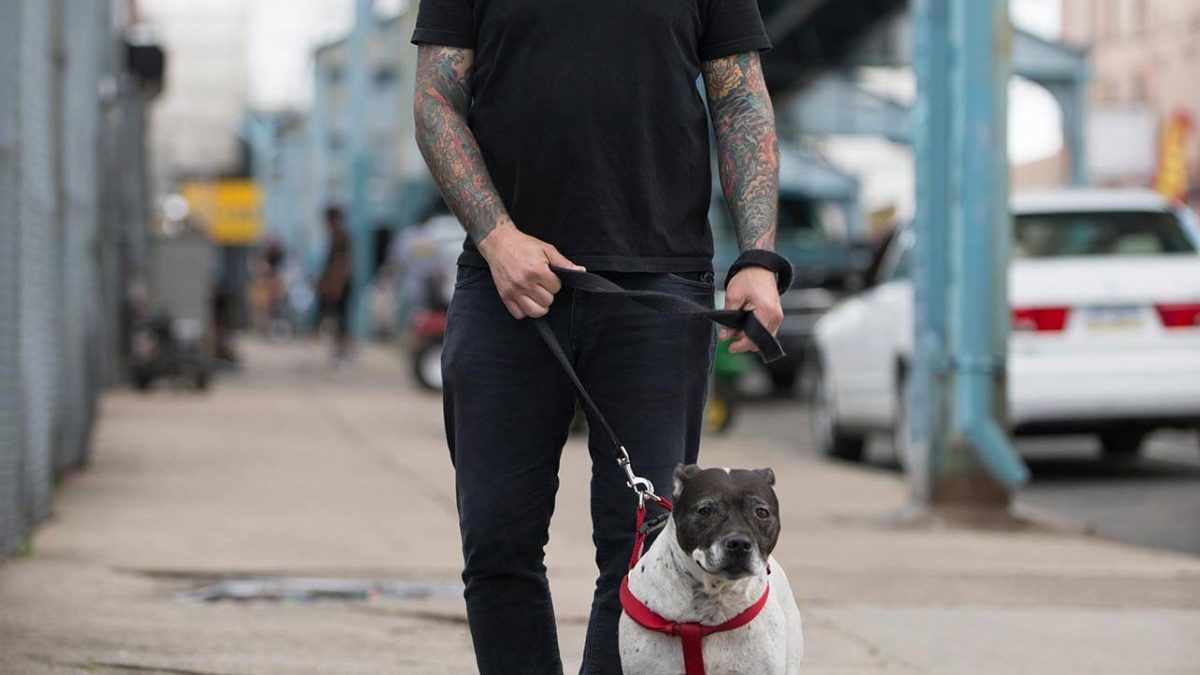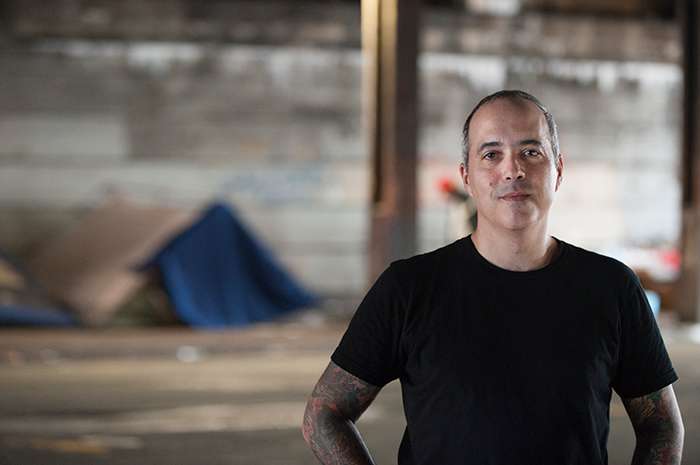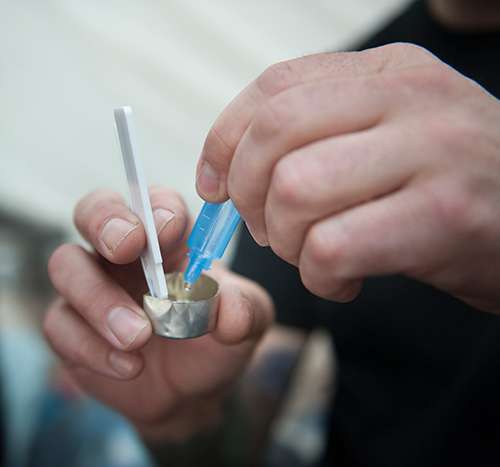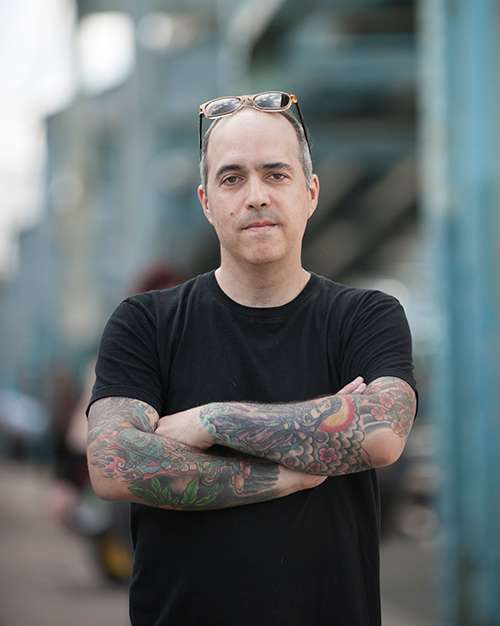Up Close and Personal With Philadelphia's Heroin Crisis
Journalist Christopher Moraff talks about a better way to report on drug culture in America.

Stories about the death toll from the opioid crisis have focused largely on the plight of rural and small-town Americans in the Midwest and Appalachia. But the perils of drug abuse and drug prohibition have also visited urban environments, and none so dramatically as Philadelphia. In 1999, the year the Centers for Disease Control and Prevention began tracking overdose fatalities by county, it topped the list of cities with populations over 1 million. For 2017, nearly 20 years later, the Philadelphia Department of Public Health reports that 1,217 residents died of a drug overdose. New York City, which has a population roughly five times that of Philadelphia, experienced only about 200 more drug poisoning deaths last year, according to a May report from that city's Department of Health and Mental Hygiene.
As in many places, the leading cause of overdose deaths is no longer prescription meds. A report from the Philadelphia Department of Public Health noted that 84 percent of such deaths involved fentanyl (or a fentanyl analog), a potent and inexpensive painkiller that dealers are increasingly mixing in to heroin to make their product cheaper. That number was up from 57 percent just a year earlier. The government response to the opioid crisis—especially the aggressive interdiction and enforcement around pain pills such as Oxycontin—has also driven up demand for heroin, making the problem worse, not better.
Philadelphia journalist Christopher Moraff has chronicled this catastrophe better than any other journalist in his city, and arguably better than anyone anywhere in the country. After a decade reporting on and working in the drug reform movement, Moraff, 47, began to regularly visit Philadelphia's heroin hub, a makeshift community called El Campamento in the Kensington neighborhood. There, amid spent needles and garbage, indigent residents built shacks out of whatever materials they could find or slept in the open air under an overpass adjacent to train tracks—until the city tore down the community last summer.
"So many of their problems come from the stigma and the illegality of drug use," Moraff says of the men and women he has spent the last two years getting to know. "We're not just criminalizing the drug, we're criminalizing people. It's a learning process that happens over time. Eventually people think of themselves as outlaws because they're using a substance that is illegal."
He has spoken extensively with these accidental outlaws, users and dealers alike. When it comes to building relationships, he acknowledges that "having had a drug history myself certainly doesn't hurt."

Moraff has taken the unprecedented step—for a journalist, anyway—of collecting and testing heroin samples. He shares his findings about the levels of fentanyl they contain on social media and in his columns for The Daily Beast. He has also helped illuminate Canada's role as a pipeline to the U.S. for counterfeit prescription drugs, examined why synthetic weed has continued to be popular in an age of increasingly legal cannabis, and shined a light on the drug rehab industry. "New laws that would put thousands of otherwise innocent Americans into locked treatment units could potentially be a windfall" for providers, Moraff writes. "But like so many other failed policies in the war on drugs, it will be the most desperate and marginalized Americans who will pay the price."
Moraff's ability to tell stories that center on users rather than law enforcement officials has earned praise from social workers, drug researchers, and other journalists. Recently, he partnered with fellow writers Zach Siegel and Troy Farah to launch a podcast called Narcotica. "We're going to try to cut through the misinformation and do some more in-depth stories, the kind of stuff you don't hear in the mainstream media," he says. "I don't think there's anybody in the podcast community that's doing it quite to the level that we're going to do it, and I think it will add some real value to this conversation."
In April, Reason's Mike Riggs spoke with Moraff about how he discovered the Kensington heroin beat and what he has learned from getting up close and personal with Philadelphia's overdose crisis.
Reason: If you were to take 10 different reporters and tell each of them to write a story about the opioid crisis, why would yours be different than the other nine?
Christopher Moraff: You have to talk to people other than researchers, public health experts, and law enforcement. For example, you could write a lot of stories about what we're spending on treatment, but it's not until you start talking to drug users that you understand what treatment even is. By doing that, you learn that more money for treatment is not necessarily a good thing. If we're not throwing money at the right treatment, more money's not gonna do anything.
I think my background in photography probably has something to do with it, too. I used to be a street photographer, so I'm really comfortable just sort of engaging people. I don't think enough reporters spend enough time in the field. Part of that has to do with the way the media business is now. We don't have the resources for it. I'm fortunate to have a moderate grant this year that's given me a little bit of space. I don't know that there's anyone, any paper or publication, that would have the resources or the dedication to spend the time to get as immersed as you need to be to really figure this out.
So instead we get a lot of news stories, especially at the biggest publications, that are regurgitating fifth- and sixth- and seventh-hand perspectives on opioids.
Which means you miss these little indicators. I'm working on the adulterated drug story right now: Street drugs are being adulterated in dangerous ways, like fentanyl added to cocaine, and we're not sure why. One media outlet reports a single death from contaminated drugs, then another re-reports that same story, and the next thing you know, we have this huge trend of cocaine adulterated with fentanyl.
But if you're not out there, you don't know the culture, which means you don't know the right questions to ask. One of those questions is: Are you testing the drugs, or are you basing this theory on postmortem toxicology? Because people use opioids and cocaine together on purpose. It's called "speedballing," and there's more of it now than there ever has been in Philadelphia. A lot of concurrent cocaine and heroin use.
Why are more people speedballing?
I think it's a result of the drop in price, first and foremost.
"When they shut the camp down, it pushed a lot of the trade and the users eastward into areas that were not established, disciplined markets."
Has cocaine gotten cheaper?
No, but heroin has. Most of the time, you're picking up a $5 bag of coke and you're dumping it all in with your heroin shot. Now, when heroin was $10 a bag, that $5 worth of coke was a big commitment, because if you had $5, you were halfway to your next heroin fix. With the price drop to $5 a bag for heroin, more people have incorporated coke.
People have always smoked crack and done heroin, but I'm seeing a lot more injection cocaine use, and I think it's definitely tied to the influx of [cheap] fentanyl, probably in more ways than one.
What other insights have you gleaned from talking to users at the street level? Are they scared that their drugs have been contaminated with fentanyl? Or do they think fentanyl is a better way to get high?
In Philadelphia, people just assume everything has fentanyl in it. I mean, there's just so much of it. But by the time it gets to the street level you're looking at very low potency. Some of these people aren't even really getting well [i.e., reversing withdrawal symptoms] off a bag or two. Even when it comes across the southwest border from Mexico, you're looking at 8 percent, 10 percent purity at most.

The heroin purity?
The fentanyl purity. It's already been diluted when it comes across the border. There was this belief that if you're buying from China, you're getting a purer and more deadly product, but I've even seen charging documents containing back-and-forth communication with Chinese vendors saying things like, "Hey, your product was inferior last time." It's not like you get a little [fentanyl] on your hand and you die, but that's the way it's been presented in the media. Not all fentanyl is the same, and not all the fentanyl markets are the same.
Don't get me wrong, people are dropping dead of fentanyl all over Philly. But the media has such a fixation on the potency of the drug that they ignore the fact that its presence here at all is an entrepreneurial innovation, a workaround to a failed drug policy [of cracking down on opioids]. You're more likely to die of an overdose after leaving jail after a period of forced abstinence than if you never got locked up in the first place.
You do your own contaminant testing of street drugs, using chemical reagent test strips that turn a certain color if fentanyl is present in a mixture. Tell me about your reasons for that.
That originally started as a journalistic mission based on a policy change that happened in Philly. We had a place called El Campamento, which was a long-established outdoor user camp secluded by the Conrail train tracks in the mostly Latino stretch of West Kensington. This was the old heroin market, where families had been in the trade for decades.
The city started catching flak for it and then Dr. Oz came here because of a Philadelphia Inquirer article that used the phrase "Heroin Hellscape" in the headline. He toured the camp with [Drug Enforcement Administration] agents and cops and cameras. After that, the city shut the camp down and made a big deal out of it. But the corners in that area had been there forever. They changed hands, but it was real professional. When they shut the camp down, it pushed a lot of the trade and the users eastward into areas that were not established, disciplined markets.
"I started testing [the heroin being sold] because I had this hypothesis that breaking down these organizations from the top…makes the drugs more dangerous and the culture more violent."
That's interesting—the black market in Kensington had some institutional structure.
For some reason, the Latino community here just got this market right. They're very businesslike. In the '90s, if you had a problem, there was a manager you could complain to. It was as legit as a black market could be.
The city disrupted this. As a result, I knew there were a lot of freelance corners popping up. I started testing because I had this hypothesis that breaking down these organizations from the top—which is the law enforcement strategy—makes the drugs more dangerous and the culture more violent. I started testing bags on the other side [of Kensington Avenue], from corners that I knew did not exist before, and comparing them to the ones on the old side, and trying to see if they were selling more fentanyl. I had this idea that if you were a young buck who was starting out, you might not have the connection that the old suppliers had, kilos of heroin coming up along the South and through Atlanta.
There's fentanyl all over Philadelphia. But almost every bag that has fentanyl without also containing some heroin has come from these new corners.
The young new freelance dealers basically have no way to do quality control.
I've talked to these old-time dealers that say, "In the old days there used to be rules. You couldn't just put anything in dope." Now, there's always been shady actors, and black markets are inherently dangerous, but there were dealers who were more legit than others. The ones people went to regularly were the ones that were established, that provided good service and consistent products. When you take down that infrastructure, you leave a void.
What do you do with this knowledge once you have it? You may know better than anyone where in Philly the drugs are most dangerous to users.
I started having to question my own ethics as a journalist. How involved do I get in this story? Am I not involved at all? Or am I telling people, "Hey, brand X has been unadulterated for the last year." Because that doesn't mean you shouldn't still be careful. I have a filing cabinet full of information, and I will share what I learn about stamps with users.
It's hard not to get emotionally connected to people that you see in desperate situations. If we have a war on drugs, this is the front lines. You're seeing the populations, the communities that are decimated by this. It's hard not to feel a sense of compassion.

What are stamps?
This doesn't apparently happen everywhere, but in Philly, New York, and Paterson, New Jersey—Northeast cities, basically—bags of heroin are stamped with a name. They do that to differentiate, because so much of the drug trade is word of mouth. As long as I can remember, dealers have bought stamps and hand stamped these bags to brand them. Some of these guys may own 15 different corners, and they might be putting out four different stamps with the same product, but that's marketing, competing against yourself.
In my experience, users of an illegal substance are easier to talk to than people who distribute those substances. Do you talk to corner guys who sell? Have you ever spoken to their bosses?
A lot of the info I get is from people who are corner dealers, but I have not got past the corner guys yet. I have two people working on that for me, and one guy seems pretty receptive. I've laid it out, like, "Dude, you can wear a fucking mask. I don't care. Your name will never be used. You don't need to bargain anonymity with me."
When I started on this 18 months ago, I thought it was going to be a lot easier to move my way up the chain, because I made a few connections. But that hasn't panned out yet. Somebody's phone gets turned off, whatever. Eventually, I want to get inside a milling operation, see them actually bagging stuff, and find out where it came from.
How do you get people to trust you? Was that something you had to earn over time, or could any journalist show up in Kensington and be like, "Hey, I'm a reporter writing about heroin, can I talk to you?"
No, I wouldn't advise it.
I'd been into drug war policy writing and drug war culture for a long time. Eventually I started visiting the camps by tagging along with community advocate types who were providing clean syringes. My first trust step was, "Oh, this is Chris." Being introduced and getting to know some of the names.
Having had a drug history myself certainly doesn't hurt. Even though it's been [more than] a decade since I was in that scene, I can say that I know what withdrawal feels like. You're in a special club if you've felt withdrawal symptoms. I wouldn't say you have to be fearless, because I get anxiety all the time, but you have to carry yourself like you belong.
Most people want to tell you their story, but you can't just go clumsily. You need to spend time around these people, and—this is a problem for some journalists—you've gotta be willing to carry a carton of Newports and hand out a few packs of cigarettes now and then.
"Don't be afraid if somebody says, 'Yeah, come in my tent and talk to me.'…I'll say, 'Are there any uncapped syringes around?' and then I go sit with them in the tent."
I understand why cigarette gifting presents an ethical problem, but I don't think it should. One explanation for the animus toward the media in America is that many of us do our jobs without a ton of regard for the people we're writing about.
Exactly. And I know I'm taking up their time. There was one story I did on a serial killer who was targeting sex workers in the Kensington area. There was a particular girl I wanted to interview, but she was working. So I said, "Hey, look, I'm taking time away from your job, so here's 20 bucks. Now you can be off the clock for 40 minutes. Talk to me." You want people to say, "Oh, this person gives a shit about me, they're not just here to come in for a couple of days and then disappear."
Don't be afraid if somebody says, "Yeah, come in my tent and talk to me." You gotta fucking be willing to do that. I'll say, "Are there any uncapped syringes around?" and then I go sit with them in the tent. You have to go where a lot of people aren't willing to go. That, in and of itself, makes people say, "This person isn't your average journalist."
Some people really just want anyone to talk to them, or to listen to them, because they've got a story to tell. They want to tell someone what they're going through. If you really want to get immersed and you really want to know who's buying what, and what dope is killing people, you need to be willing to provide a level of trust. You need to be compassionate. Some journalists don't get that.
Do you believe we should legalize drugs?
Ultimately, I do. I would love to see a regulated legal market. But we're not ready for that. We need a complete re-education campaign, because you know what it looks like when you go to a party and there's the bad drinker, right?
Totally.
You can distinguish good drinking from bad drinking, but we've never had that dialogue around illegal drugs. We're starting to have it now, but we've mostly always focused on the very worst ramifications of drug use. We need a complete public education campaign around how these mood-altering substances can be used healthily, because nobody teaches that. Harm reductionists are doing a great job at teaching people how to prevent and reverse overdoses, but the maintenance of recreational use is not something we talk about. You're expected to become the crackhead. Nobody tells you that you don't have to be that, even though you know you don't have to be the drunk. You can socially drink. Maybe not everybody can, but we just don't have a cultural image of what that looks like.
What is it like to spend so much time around people who are suffering both from the effects of prohibition and from drug addiction?
You get sucked into the community and it becomes hard to not be there all the time. I get phone calls from jail. I get phone calls from people's mothers that are looking for them. You almost get addicted to the beat. And it's not even my full-time gig. I write stories for The Daily Beast, too, and I do a lot of other stuff. Even though I live close by, I have so many other responsibilities that I don't always get to spend as much time talking to users and corner guys as I want. Today, I'm planning on going and spending all afternoon, or part of the afternoon, with this girl who's a user, but she also does "service." She'll take drugs or money in return for injecting people that can't inject themselves.
Other than writing, what are you planning to do with the research you've gathered?
I'm trying to find a way to take all this intelligence that I have and package it and present it in a way that I think is emotive, provocative, and comes from the people themselves rather than filtered through me.
This interview has been condensed and edited for style and clarity.
This article originally appeared in print under the headline "Up Close and Personal With Philadelphia's Heroin Crisis."


Show Comments (44)